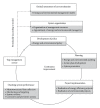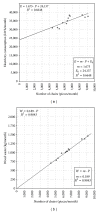Integrating energy and environmental management in wood furniture industry
- PMID: 24587734
- PMCID: PMC3918744
- DOI: 10.1155/2014/596958
Integrating energy and environmental management in wood furniture industry
Abstract
As energy costs continue to rise, industrial plants (even those of energy nonintensive industries such as furniture industry) need effective way to reduce the amount of energy they consume. Besides, there are a number of economic and environmental reasons why a company should consider environmental management initiatives. This paper provides a detailed guideline for implementing joint energy and environmental management system in wood furniture industrial company. It covers in detail all essential aspects of the system: initial system assessment, organization, policy development, energy and environmental auditing, action plan development, system promotion, checking system performance, and management review.
Figures







Similar articles
-
Furniture manufacturing: a step-by-step profile.Occup Health Saf. 1981 Jul;50(7):23-5, 28, 30 passim. Occup Health Saf. 1981. PMID: 7243152
-
Eco-innovation of a wooden childhood furniture set: an example of environmental solutions in the wood sector.Sci Total Environ. 2012 Jun 1;426:318-26. doi: 10.1016/j.scitotenv.2012.03.077. Epub 2012 Apr 25. Sci Total Environ. 2012. PMID: 22542234
-
Assessing the global warming potential of wooden products from the furniture sector to improve their ecodesign.Sci Total Environ. 2011 Dec 1;410-411:16-25. doi: 10.1016/j.scitotenv.2011.09.059. Epub 2011 Oct 15. Sci Total Environ. 2011. PMID: 22000917
-
Current status and system construction of used-furniture recycling in China.Environ Sci Pollut Res Int. 2022 Nov;29(55):82729-82739. doi: 10.1007/s11356-022-23532-5. Epub 2022 Oct 12. Environ Sci Pollut Res Int. 2022. PMID: 36224464 Review.
-
A review of nasal cancer in furniture manufacturing and woodworking in North Carolina, the United States, and other countries.J Occup Med. 1987 Sep;29(9):734-40. J Occup Med. 1987. PMID: 3316543 Review.
Cited by
-
Antioxidative and Antimicrobial Evaluation of Bark Extracts from Common European Trees in Light of Dermal Applications.Antibiotics (Basel). 2023 Jan 9;12(1):130. doi: 10.3390/antibiotics12010130. Antibiotics (Basel). 2023. PMID: 36671331 Free PMC article. Review.
-
Multilayer perceptron-genetic algorithm as a promising tool for modeling cultivation substrate of Auricularia cornea Native to Iran.PLoS One. 2023 Feb 21;18(2):e0281982. doi: 10.1371/journal.pone.0281982. eCollection 2023. PLoS One. 2023. PMID: 36809254 Free PMC article.
-
Lentinula edodes substrate formulation using multilayer perceptron-genetic algorithm: a critical production checkpoint.Front Microbiol. 2024 May 21;15:1366264. doi: 10.3389/fmicb.2024.1366264. eCollection 2024. Front Microbiol. 2024. PMID: 38841070 Free PMC article.
References
-
- Morvay Z, Gvozdenac D. Applied Industrial Energy and Environmental Management. Chichester, UK: John Wiley & Sons; 2008.
-
- Hepbasli A, Ozalp N. Development of energy efficiency and management implementation in the Turkish industrial sector. Energy Conversion and Management. 2003;44(2):231–249.
-
- Gordic D, Babic M, Sustersic V, Jovicic N, Koncalovic D, Jelic D. Development of energy management system: case study of serbian car manufacturer. Energy Conversion and Management. 2010;51(12):2783–2790.
-
- Capeheart BL, Turner WC, Kennedy WJ. Guide to Energy Management. 5th edition. Lilburn, Ga, USA: The Fairmont Press; 2006.
-
- Jelić D, Gordić D, Babić M, Končalović D, Šušteršič V. Review of existing energy management standards and possibilities for its introduction in Serbia. Thermal Science. 2010;14(3):613–623.
Publication types
MeSH terms
LinkOut - more resources
Full Text Sources
Other Literature Sources
Research Materials

